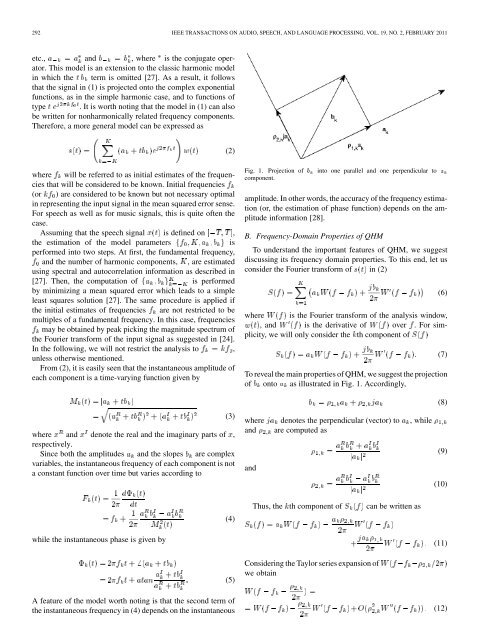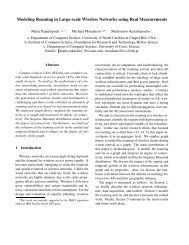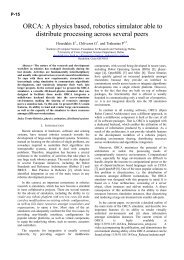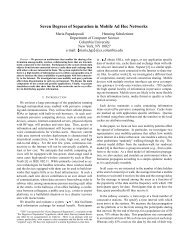Adaptive AM–FM Signal Decomposition With Application to ... - ICS
Adaptive AM–FM Signal Decomposition With Application to ... - ICS
Adaptive AM–FM Signal Decomposition With Application to ... - ICS
Create successful ePaper yourself
Turn your PDF publications into a flip-book with our unique Google optimized e-Paper software.
292 IEEE TRANSACTIONS ON AUDIO, SPEECH, AND LANGUAGE PROCESSING, VOL. 19, NO. 2, FEBRUARY 2011<br />
etc., and , where is the conjugate opera<strong>to</strong>r.<br />
This model is an extension <strong>to</strong> the classic harmonic model<br />
in which the term is omitted [27]. As a result, it follows<br />
that the signal in (1) is projected on<strong>to</strong> the complex exponential<br />
functions, as in the simple harmonic case, and <strong>to</strong> functions of<br />
type . It is worth noting that the model in (1) can also<br />
be written for nonharmonically related frequency components.<br />
Therefore, a more general model can be expressed as<br />
(2)<br />
where will be referred <strong>to</strong> as initial estimates of the frequencies<br />
that will be considered <strong>to</strong> be known. Initial frequencies<br />
(or ) are considered <strong>to</strong> be known but not necessary optimal<br />
in representing the input signal in the mean squared error sense.<br />
For speech as well as for music signals, this is quite often the<br />
case.<br />
Assuming that the speech signal is defined on ,<br />
the estimation of the model parameters<br />
is<br />
performed in<strong>to</strong> two steps. At first, the fundamental frequency,<br />
and the number of harmonic components, , are estimated<br />
using spectral and au<strong>to</strong>correlation information as described in<br />
[27]. Then, the computation of is performed<br />
by minimizing a mean squared error which leads <strong>to</strong> a simple<br />
least squares solution [27]. The same procedure is applied if<br />
the initial estimates of frequencies are not restricted <strong>to</strong> be<br />
multiples of a fundamental frequency. In this case, frequencies<br />
may be obtained by peak picking the magnitude spectrum of<br />
the Fourier transform of the input signal as suggested in [24].<br />
In the following, we will not restrict the analysis <strong>to</strong> ,<br />
unless otherwise mentioned.<br />
From (2), it is easily seen that the instantaneous amplitude of<br />
each component is a time-varying function given by<br />
where and denote the real and the imaginary parts of ,<br />
respectively.<br />
Since both the amplitudes and the slopes are complex<br />
variables, the instantaneous frequency of each component is not<br />
a constant function over time but varies according <strong>to</strong><br />
while the instantaneous phase is given by<br />
A feature of the model worth noting is that the second term of<br />
the instantaneous frequency in (4) depends on the instantaneous<br />
(3)<br />
(4)<br />
(5)<br />
Fig. 1. Projection of b<br />
component.<br />
in<strong>to</strong> one parallel and one perpendicular <strong>to</strong> a<br />
amplitude. In other words, the accuracy of the frequency estimation<br />
(or, the estimation of phase function) depends on the amplitude<br />
information [28].<br />
B. Frequency-Domain Properties of QHM<br />
To understand the important features of QHM, we suggest<br />
discussing its frequency domain properties. To this end, let us<br />
consider the Fourier transform of in (2)<br />
where is the Fourier transform of the analysis window,<br />
, and is the derivative of over . For simplicity,<br />
we will only consider the th component of<br />
To reveal the main properties of QHM, we suggest the projection<br />
of on<strong>to</strong> as illustrated in Fig. 1. Accordingly,<br />
where denotes the perpendicular (vec<strong>to</strong>r) <strong>to</strong> , while<br />
and are computed as<br />
and<br />
Thus, the th component of can be written as<br />
Considering the Taylor series expansion of<br />
we obtain<br />
(6)<br />
(7)<br />
(8)<br />
(9)<br />
(10)<br />
(11)<br />
(12)
















